How Do Underground Stems Help Plants Survive?
We can see lots of plants around us and they are of different types. The plants have different parts and the stem is the support system of plants. The stem is the ascending part and it bears leaves, fruits and branches.
The stem has nodes and internodes. The nodes are the region from which the plants originate. Internodes are those between two nodes. The stem has many functions. Some of them include the storage and transportation of food, water and nutrients, vegetative propagation, and bearing of leaves and fruits. There are three types of stems. They are underground stem, aerial stem, and subaerial stem.
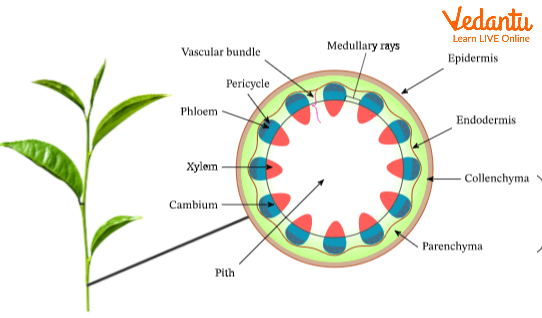
Stem Structure of a Plant
Underground Stem: The Storage Hub of Plants
Underground stems are those which are modified plants. They are derived from tissues of the stem and grow under the soil. To transport water and nutrients to and from the leaves and flowers, the stems are modified. Unlike roots, stems have nodes with buds where leaves and flowers can grow in specified places. Plants use underground stems to reproduce asexually and live from one year to the next, generally during a time of hibernation.
Some plants develop stems that have been modified to store energy and protect a spot for future growth to survive a cold or dry time. Once that period has passed, the plants then start growing again from the underground stems. Being underground shields the stems from the weather and fire. They can also shield plants from animals. Many plants, especially weedy ones, spread and occupy vast regions through underground stems.
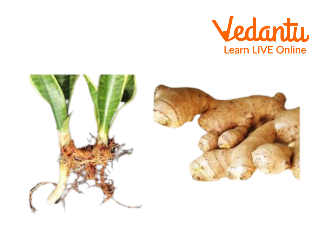
Underground Stems
Modifications of Stem
Many plants have modified stems that serve a variety of uses, including storage, protection, photosynthesis, support, propagation, etc. Modifications facilitate improved adaptation and survival.
Types of Underground Stem Modifications
There are different types of underground stems. They include rhizomes, bulbs, corms, stolon, and tubers. Rhizomes have distinct nodes and internodes and are non-green. These are brownish. Due to the storage of food material, the main forms of rhizomes are fleshy. Rhizome rootstock grows vertically upward. Alocasia, Iris and banana are two examples of rhizomes.
Bulbs have several leaves with fleshy scales. A collection of adventitious roots makes up the bulb's base. For example, onions and garlic. The corm has a flattened base and a spherical form. Its internodes and nodes are distinct. Adventitious roots can be found at the body's base and there are axillary buds. For example, Colocasia.
A tuber is a fleshy component of the plant that stores food. The most common tuber is the potato. It has several depressions called "eye" and each eye refers to a node. These grow quite slowly and are mostly used as food.

Underground Stem Modifications
Types of Aerial Stem Modifications
To carry out tasks including climbing, food storage, vegetative proliferation, and protection, the stems are modified into aerial forms.
Stem Tendrils are modified stems that are leafless, threadlike structures. The purpose of them is for climbing. The stem tendrils can be: axillary: For example, Passiflora, extra-axillary: for example, Luffa, apical bud, such as grapevine, and floral bud, such as the antigonon.
Thorns are sharp, rigid objects that might or might not have leaves, branches, and flowers. Thorns develop on the terminal bud. Thorns serve as defensive tools and control transpiration. Example: Bougainvillea.
Phylloclades are leaves that have been transformed into scales or spines to control transpiration. By limiting the growth of the leaves, this is achieved. These participate in photosynthesis and are fleshy and green. Xerophytic plants like opuntia exhibit this modification, which retains water. It has leaves converted into spines or tiny scaly leaves and mushy internodes.
Cladodes are a particular variety of phylloclade that has just one internode. Photosynthesis is aided by these. One example is asparagus. Here the leaves have been modified to have prickles. Bulbils are modified axillary floral or vegetative buds modified to store food. They develop into new plants through vegetative propagation. One example is Dioscorea. Thalamus functions as the flower's axis and contains the calyx, corolla, androecium, and gynoecium. Clear nodes and internodes can be seen in Silene.
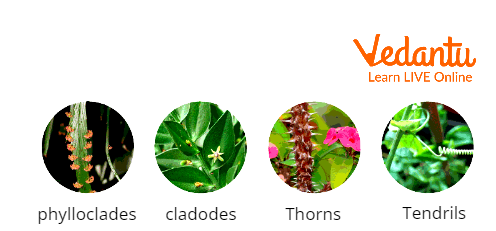
Aerial Modification of Stem
Can We Eat the Stem?
Yes, we can eat the stem. A modified stem is a storage house of food and nutrients. So these can be consumed by human beings and other living beings. Some of them are:
Potatoes
Asparagus
Cauliflower
Kohlrabi
Bamboo
Sugarcane
Celery
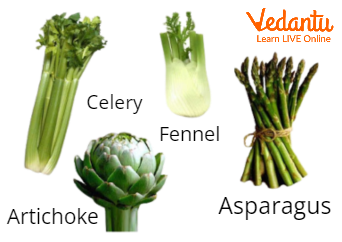
Edible Stems
Parts of a Stem
A typical plant stem is made up of eight different parts, six of which are elements and two of which are organs. Nodes, internodes, terminal or apical buds, lateral or axillary buds, petiole, and pedicel are the first six components. While the two organs are flowers and leaves, respectively.
Nodes – Provide structural support and help to heal injuries.
Internodes – They are the blood vessels that carry food and nutrients between two nodes.
Terminal buds – Provides growth hormones.
Lateral buds – Helps to develop the vegetative parts of the plant.
Petiole – It provides strength and support to the leaf.
Pedicel – Helps in attracting pollinators.
Flowers – Helps in the sexual reproduction of plants.
Leaves – Helps in photosynthesis.
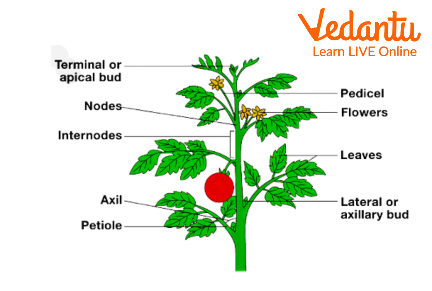
Parts of the Stem
Important Questions
1. Underground parts of plants are not always roots. Justify.
Ans: Not all underground plant parts are roots because oftentimes the stem also goes underground and develops into different forms to serve diverse tasks including storage, vegetative propagation, perennation, etc. Tuber, rhizome, corm, and bulb are underground stem modifications. The existence of nodes and internodes, axillary buds, scale leaves, etc., as well as the absence of a root cap and root hairs, allow one to identify underground stems from roots from the outside. Thus all underground parts of the plants are not always roots.
2. What are some functions of the stem?
Ans: The elevation of flowers, leaves, and fruits is supported by the stem. It aids in transportation while also storing nutrients. Meristems found in stems aid in the growth of new living tissue.
Practise Questions
Potato tuber is an underground stem because ___________.
Thorns and spines are _______.
Answers
It lacks axillary buds
Homologous organs
Key Features
Stem is an integral part of the plant. The stem gives support to the plant and it is the storage hub of the plants.
The stem stores and transports food and other nutrients. Also, it supports transpiration. The stem is modified for better survival and adaptation.
There are three types of stem modification. Stem modifications also help in the storage of food and nutrients.
The stem can be consumed by living beings as it is a storehouse of nutrients.


FAQs on Underground Stem: Structure, Types, and Importance
1. What is an underground stem?
An underground stem is a modified plant stem that grows beneath the surface of the soil. Unlike a root, it possesses distinct features such as nodes (points where leaves and buds arise), internodes (the sections between nodes), scale leaves, and buds. These stems are primarily adapted for food storage and vegetative propagation.
2. What are the main types of underground stem modifications?
The major types of underground stem modifications are based on their structure and function. The four main types are:
- Rhizome: A fleshy, horizontally growing stem with distinct nodes and internodes. It bears scale leaves and buds. Examples include ginger and turmeric.
- Tuber: The swollen, fleshy end of an underground branch that stores a large amount of food, mainly starch. It has several buds called 'eyes'. The most common example is the potato.
- Corm: A condensed, solid, fleshy, and unbranched stem that grows vertically in the soil. It stores food and bears buds for new growth. Examples include Colocasia (Arbi) and Gladiolus.
- Bulb: A highly reduced, disc-like stem surrounded by fleshy, concentric layers of scale leaves that store food. A terminal bud is present in the centre. Examples include onion and garlic.
3. How can you distinguish an underground stem from a root?
While both grow underground, a stem can be distinguished from a root by several key features. An underground stem has nodes and internodes, which are absent in roots. Stems also possess scale leaves and axillary buds (like the 'eyes' of a potato), which roots lack. Conversely, roots are characterized by the presence of a root cap at their tip and fine root hairs for absorption, neither of which is found on a stem.
4. What are some common examples of edible underground stems?
Many common vegetables are actually modified underground stems. Some well-known examples include the potato (a tuber), ginger and turmeric (both rhizomes), onion and garlic (both bulbs), and Colocasia or Arbi (a corm). These stems are consumed because they are rich in stored nutrients like starch and sugars.
5. What is the primary function of an underground stem, and why does it grow below the surface?
The primary functions of an underground stem are food storage and perennation. Perennation is the ability of the plant to survive unfavourable conditions like extreme cold, heat, or drought. By growing underground, the stem is protected from harsh surface temperatures, fire, and grazing animals. It acts as a reserve, allowing the plant to regrow when favourable conditions return.
6. How do underground stems like rhizomes and tubers help in vegetative propagation?
Underground stems are excellent organs for vegetative propagation because they contain buds. In tubers like potatoes, the 'eyes' are axillary buds that can sprout to form new shoots and roots, growing into a new plant. Similarly, rhizomes like ginger have buds at their nodes. If a piece of the rhizome containing at least one bud is planted, it can grow into a complete, genetically identical plant. This allows for rapid multiplication.
7. What is the difference between a corm and a bulb?
The main difference lies in where the food is stored. In a corm (like Colocasia), the food is stored in the solid, fleshy, swollen stem tissue itself. In a bulb (like an onion), the stem is a highly reduced, disc-like structure at the base, and the food is stored in the surrounding fleshy, layered scale leaves.
8. Besides food storage, what survival advantages do underground stems provide?
Beyond just storing food, underground stems offer significant survival advantages. Their primary advantage is protection from environmental stress, such as winter frost or summer drought, allowing the plant to enter a dormant state. They are also protected from being eaten by most surface-dwelling herbivores. This hidden position ensures the plant's survival and allows it to resprout and colonise an area quickly when conditions improve.










